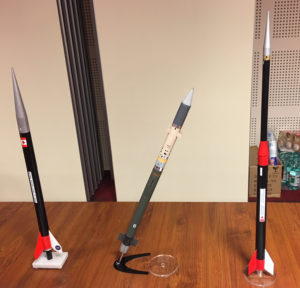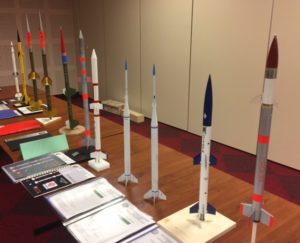S5 – Scale Altitude
EVENT HIGHLIGHTS
- Fly a scale model of a real rocket to a high altitude
- Score is the sum of static judging score (max 600 points) and altitude (in meters)
- Juniors fly S5B (B motor), Seniors fly S5C (C motor)
- Altitude is measured using an electronic altimeter
- S5B dimension requirements: min length = 500 mm, min diameter = 25 mm for at least 50% of rocket length
- S5C dimension requirements: min length = 600 mm, min diameter = 30 mm for at least 50% of rocket length
- Three flight rounds, with altitude score based on best altitude of the three rounds
OVERVIEW
 S5 (Scale Altitude) is a challenging event that combines the points achieved for static craftsmanship with the altitude achieved by the model in flight. Static judging is the same as S7 (see S7 rules). The altitude achieved in meters is added to the static points to determine the overall score. The objective is to gain as many points possible between craftsmanship and altitude. There is a significant trade-off between simple model/high altitude and detailed model/lower altitude.
S5 (Scale Altitude) is a challenging event that combines the points achieved for static craftsmanship with the altitude achieved by the model in flight. Static judging is the same as S7 (see S7 rules). The altitude achieved in meters is added to the static points to determine the overall score. The objective is to gain as many points possible between craftsmanship and altitude. There is a significant trade-off between simple model/high altitude and detailed model/lower altitude.
RULES UPDATE
The dimension rules for S5 changed significantly in the 2015 edition of the FAI Code. For S5B, the minimum diameter is 25 mm for at least 50% of the the length, and the minimum length is 500 mm. For S5C, the minimum diameter is 30 mm for at least 50% of the the length, and the minimum length is 600 mm.
Beginning with the 2019 contest cycle, piston launchers are prohibited from S5 and other altitude events.
COMPETITION MODELS
 S5 models must be accurate scale models of actual prototypes. To achieve high altitudes, the selected prototypes are usually high altitude sounding rockets.
S5 models must be accurate scale models of actual prototypes. To achieve high altitudes, the selected prototypes are usually high altitude sounding rockets.
The new dimension requirements for S5 favor prototypes that have a length-to-diameter ratio of approximately 20. Fortunately, there are a wide variety of prototypes that have satisfactory length/diameter dimensions, such as the following:
- Sonda II – 19.7
- ARCAS – 20.1
- Black Brant III – 21.1
- D-Region Tomahawk – 21.6
- Viper – 22.6
- Black Brant VI – 22.6
… and many more.
Models may be flown as single stage or multi-stage. At this time, most of the winning models have been single stage. However, a two-stage model might be superior with the appropriate prototype and motor selection.
There is a significant tradeoff between static score and altitude. Some modelers build highly detailed models to maximize the static score. However, these models generally have lower altitudes. Another strategy is to build a simple, aerodynamically clean model such as an ARCAS. This type of model will get a lower static score but a higher altitude. The optimum balance of detail versus altitude is not well defined at this point. In addition, the optimum balance may be different between S5B (Juniors) and S5C (Seniors).
Selecting an unusual prototype can get a full score for Originality (40 points). This is equivalent to an extra 40 meters of altitude. However, be careful not to compromise altitude or details just to select a unique prototype.
The current length/diameter requirement has stimulated the selection of a wide variety of prototypes. A dominant prototype has not yet emerged. Placing models have included SS-520, TT-500, MMR-06m (DART configuration), ST-735, K-10, Black Brant IV, ARCAS, and D-Region Tomahawk. The MMR-06m (DART) has become popular among European entries and would therefore be very unlikely to get any Originality points.
COMPETITION STRATEGIES
 If you’re going to spend months crafting a competitive S5 model, remember that, once you ignite the motor, it’s just an altitude model! Don’t begin by building a scale model without thinking through your flight strategy. Build numerous “boilerplate” models. Test fly all aspects of your flight, most importantly staging (if used) and recovery techniques. Test flying and data acquisition could occupy most of your modeling time, but can also be the most fun and rewarding.
If you’re going to spend months crafting a competitive S5 model, remember that, once you ignite the motor, it’s just an altitude model! Don’t begin by building a scale model without thinking through your flight strategy. Build numerous “boilerplate” models. Test fly all aspects of your flight, most importantly staging (if used) and recovery techniques. Test flying and data acquisition could occupy most of your modeling time, but can also be the most fun and rewarding.
Select a competitive prototype that can be easily documented for scale. Obscure rockets might be very efficient and adhere closely to established minimum size constraints, but documentation and color photographs may prove difficult to locate. Have the minimum data on a number of prototypes and possibly locate a bit more before selecting the one you wish to model.
These “scale” models cannot be built “heavily” to survive numerous flights and still be competitive. Most winning S5 models are altitude models in disguise; they merely appear to be a scale model on the outside. Begin by designing an altitude model and figure out how to add the detail to it. Remember to tune your model to the optimum mass.
Some European modelers have sacrificed scale detailing to increase altitude potential. By omitting projections on the surface of the sustainer to reduce drag, much higher altitudes can be achieved. With proper considerations this can sometimes be an even more than reasonable trade for the loss in static points. There is a saying at the WSMC that “he who places first in S5 static, never wins.” Many times models ranked in the middle third of the static scores will actually win the contest by posting superb altitudes. Your static score should be reasonably good or better, but to win consistently takes a very good “altitude” potential.
 Keep in mind that weather conditions may be poor on the day of the contest. Practice flying in bad weather conditions, and expect to loose some boilerplate models. Remember, it’s OK to ruin boilerplate models; the knowledge gained could save you from disaster in a competition that is held only once every two years.
Keep in mind that weather conditions may be poor on the day of the contest. Practice flying in bad weather conditions, and expect to loose some boilerplate models. Remember, it’s OK to ruin boilerplate models; the knowledge gained could save you from disaster in a competition that is held only once every two years.